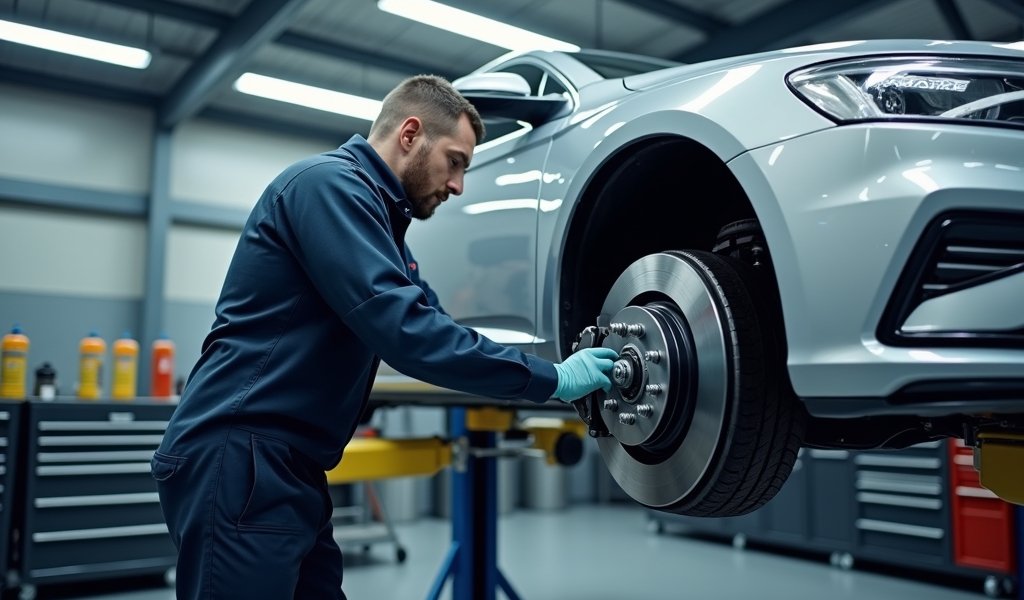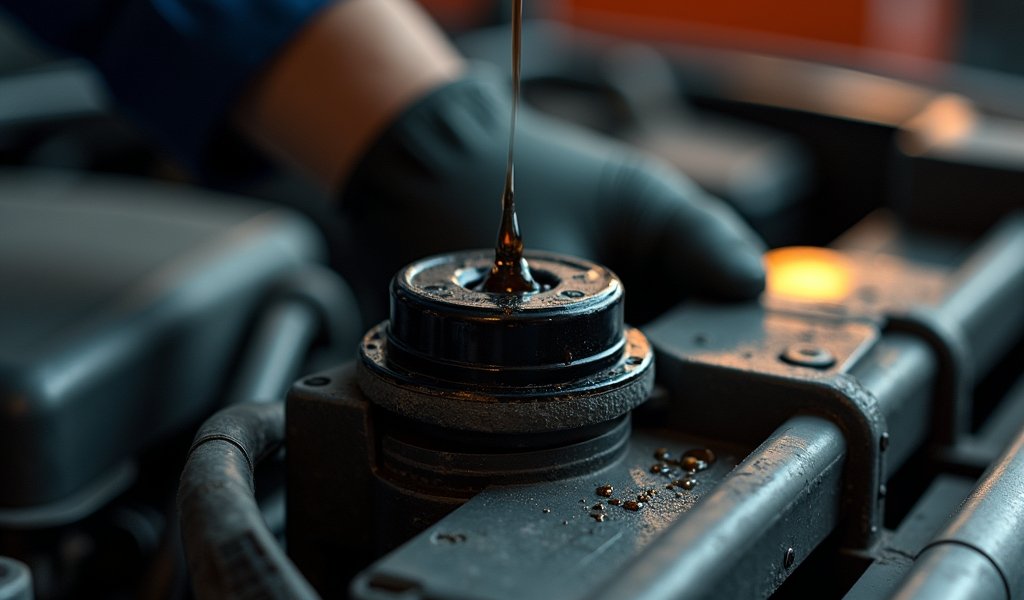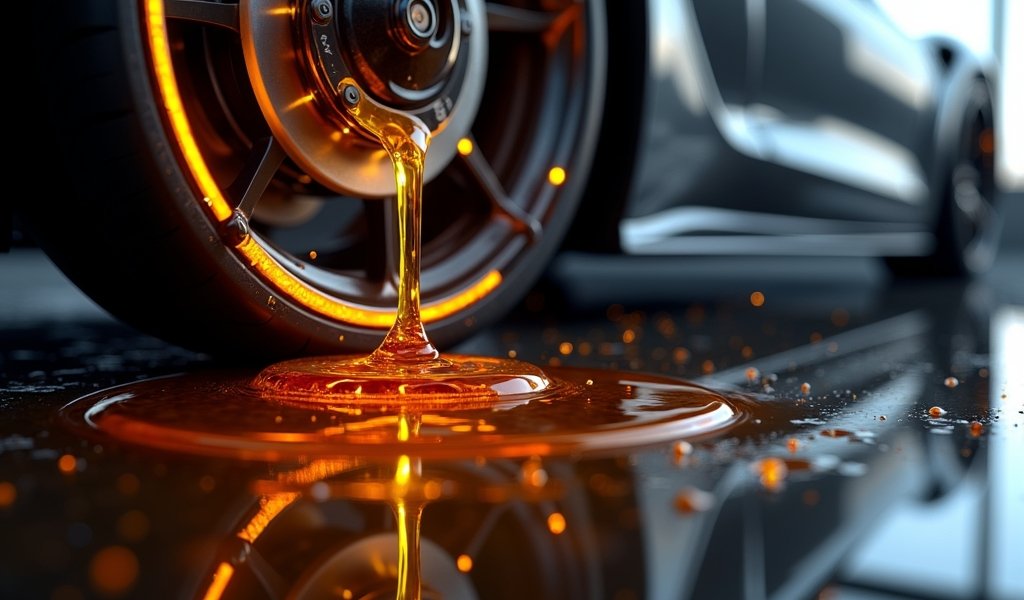Overview
This article explains the critical importance of choosing the correct brake fluid (DOT 3, 4, 5, or 5.1) based on vehicle requirements and driving conditions, emphasizing how each type has different boiling points, viscosity, and compatibility properties. It provides practical maintenance advice including regular fluid changes every 2-3 years, proper testing methods, and common mistakes to avoid, all to ensure optimal braking performance and safety.
Table of Contents
- Understanding Brake Fluid: The Lifeblood of Your Braking System
- DOT Specifications Explained: What They Mean for Your Vehicle
- Comparing DOT Types: Finding the Right Match for Your Vehicle
- Key Properties That Make Brake Fluid Work
- Choosing the Right Fluid for Your Vehicle
- Maintenance Tips: Keeping Your Brake Fluid in Top Condition
- Common Mistakes to Avoid with Brake Fluid
- Conclusion: Safety First with Proper Brake Fluid
- Frequently Asked Questions
Understanding Brake Fluid: The Lifeblood of Your Braking System
When it comes to vehicle safety, brake fluid DOT specification requirements might not be the most exciting topic, but they’re absolutely critical. As a mechanic who’s seen the consequences of neglected brake fluid firsthand, I can tell you this often-overlooked fluid is essentially the lifeblood of your entire braking system.
Brake fluid works by transferring force from your foot on the brake pedal to the actual brake mechanisms at each wheel. When you press down, that pressure travels through the hydraulic system to activate your brakes. It’s a simple concept with life-saving implications.
Unlike other fluids in your vehicle, brake fluid operates in a sealed system under extreme pressure and temperature conditions. According to a NHTSA study, brake-related problems contribute to approximately 22% of crashes caused by vehicle failure. Many of these issues stem from improper brake fluid maintenance or using the wrong type.
Ever wonder why there are different types of brake fluid? It’s not just to confuse you at the auto parts store! Each specification serves a specific purpose and meets different performance standards set by the Department of Transportation (DOT). Let’s demystify these specifications so you can make informed decisions about this vital safety component.
DOT Specifications Explained: What They Mean for Your Vehicle
The Department of Transportation doesn’t create these specifications just for fun. These standards ensure that the fluid in your braking system can handle the demands of modern driving conditions while providing consistent, reliable performance.
The DOT classification system primarily focuses on boiling points, both dry (new fluid) and wet (after moisture absorption). Here’s why that matters: when brake fluid gets too hot and boils, it creates gas bubbles in your brake lines. Unlike liquid, these gas bubbles can compress, leading to a spongy brake pedal or even complete brake failure.
Let me break down the four main DOT classifications in simple terms:
- DOT 3: The traditional workhorse (glycol-based, dry boiling point: 401°F, wet: 284°F)
- DOT 4: Enhanced performance for modern vehicles (glycol-based, dry boiling point: 446°F, wet: 311°F)
- DOT 5: The silicone alternative (silicone-based, dry boiling point: 500°F, wet: 356°F)
- DOT 5.1: High-performance glycol (glycol-based but performs like DOT 5, dry boiling point: 500°F, wet: 356°F)
Approximately 67% of new vehicles now come from the factory with DOT 4 fluid, reflecting the industry’s shift toward more advanced braking systems that generate higher operating temperatures.

Comparing DOT Types: Finding the Right Match for Your Vehicle
Let’s get into the nitty-gritty of each DOT type so you can understand which one belongs in your vehicle.
DOT 3: The Traditional Standard
Think of DOT 3 as the reliable workhorse that’s been serving vehicles for decades. It’s glycol-based, which means it absorbs moisture over time (hygroscopic). This isn’t necessarily a bad thing—it prevents water pockets from forming in your brake system that could cause corrosion or freezing.
DOT 3 works perfectly fine for many standard passenger vehicles in normal driving conditions. It’s typically clear to amber in color and has served faithfully in millions of vehicles. However, its lower boiling points make it less suitable for high-performance applications or vehicles with advanced braking systems.
One significant drawback: as DOT 3 absorbs moisture, its boiling point progressively decreases. This is why manufacturers typically recommend changing it every 2-3 years, regardless of mileage.
DOT 4: Enhanced Performance for Modern Vehicles
As vehicles have evolved with anti-lock brakes, stability control, and other advanced systems, DOT 4 has become increasingly common. It contains borate esters that give it higher boiling points than DOT 3, making it better suited for the demands of modern braking systems.
If you do a lot of stop-and-go driving in traffic or live in mountainous areas where your brakes work harder, DOT 4 offers that extra margin of safety. It’s still hygroscopic but handles moisture better than DOT 3.
Most European vehicles and many newer domestic models specify DOT 4, and it’s generally compatible with systems designed for DOT 3. When in doubt, upgrading from DOT 3 to DOT 4 is usually acceptable, but the reverse isn’t always true.
DOT 5: The Silicone Alternative
DOT 5 breaks the mold with its silicone-based formula. The most noticeable difference is that it’s typically purple in color for easy identification. Unlike glycol-based fluids, DOT 5 doesn’t absorb water, which helps it maintain its performance characteristics over time.
This makes it ideal for specific applications like:
- Classic cars that might sit unused for extended periods
- Vehicles in extremely humid environments
- Military vehicles that need long-term storage capabilities
However, DOT 5 isn’t a universal upgrade. It can trap air more easily, potentially causing a spongy brake pedal. More critically, it should never be mixed with other DOT fluids—they’re about as compatible as oil and water.
DOT 5.1: The Best of Both Worlds
Despite what the name suggests, DOT 5.1 is not an improved version of DOT 5. It’s actually more related to DOT 3 and DOT 4 as it’s glycol-based, not silicone. What makes it special is that it delivers the high-temperature performance of DOT 5 while maintaining compatibility with traditional glycol systems.
This makes DOT 5.1 perfect for high-performance vehicles, heavy towing applications, and track day enthusiasts. It’s like getting sports car performance with family car compatibility. You’ll find it in many performance vehicles and racing applications where brakes regularly reach high temperatures.
Key Properties That Make Brake Fluid Work
Beyond the DOT classifications, there are several properties that make brake fluid work effectively in your vehicle. Understanding these can help you appreciate why using the right fluid matters.
Boiling Point: The Critical Safety Factor
I’ve mentioned boiling points before, but they’re worth emphasizing. When you apply your brakes repeatedly (like driving downhill or in stop-and-go traffic), heat builds up. If your brake fluid boils, gas bubbles form in the lines, creating a spongy pedal or even total brake failure.
There are two important temperature specifications:
- Dry Boiling Point: The temperature at which new, unused fluid will boil
- Wet Boiling Point: The temperature at which fluid containing 3.7% water (typical after 1-2 years of service) will boil
The wet boiling point is arguably more important as it represents real-world conditions. Research from the Society of Automotive Engineers shows that after two years, brake fluid can absorb enough moisture to lower its boiling point by 25-30%.
Viscosity: Flowing When It Matters
Brake fluid must flow properly across an enormous temperature range—from below freezing to well over 300°F in extreme conditions. If it’s too thick in cold weather, it won’t flow quickly enough when you need to stop. If it’s too thin when hot, it might not provide adequate pressure.
DOT standards require brake fluid to maintain appropriate viscosity from -40°F to over 200°F in normal operation. This is why using the correct specification matters—each formula is engineered to maintain the right flow characteristics under different conditions.
Corrosion Protection: Defending Your System
Modern brake systems contain various metals including aluminum, steel, cast iron, and copper. Brake fluid contains corrosion inhibitors specifically designed to protect these components.
This is another reason regular fluid changes matter. As fluid ages, these corrosion inhibitors get depleted, potentially leading to internal damage that can compromise safety and lead to expensive repairs.
Water Tolerance: The Double-Edged Sword
Glycol-based brake fluids (DOT 3, DOT 4, and DOT 5.1) absorb moisture from the air over time. While this seems like a disadvantage, it’s actually by design. By absorbing water, the fluid prevents pockets of moisture from forming in the brake system where they could cause corrosion or freeze in cold temperatures.
The trade-off is that this moisture gradually lowers the fluid’s boiling point. After about two years in service, many vehicles’ brake fluid has absorbed enough moisture to significantly reduce its effectiveness, which is why regular fluid changes are essential.
Choosing the Right Fluid for Your Vehicle
Selecting the right brake fluid isn’t simply a matter of grabbing the highest specification off the shelf. Here’s how to make the right choice:
Follow Manufacturer Recommendations
Your vehicle’s owner’s manual specifies the minimum DOT classification required. This recommendation takes into account:
- The design of your specific braking system
- Expected operating temperatures
- Materials used in seals and components
According to a recent survey, approximately 38% of car owners have never checked their owner’s manual for the recommended brake fluid specification. This oversight could potentially compromise your vehicle’s braking performance and safety.
Consider Your Driving Conditions
Your typical driving environment should influence your choice:
- Heavy traffic: Frequent stops generate more heat in the braking system
- Mountainous terrain: Descending long grades raises brake temperatures significantly
- Towing or heavy loads: Increases demands on your braking system
- Performance driving: Track days or spirited driving requires higher-performance fluid
In these more demanding situations, you might consider upgrading to a higher-specification fluid like DOT 4 or DOT 5.1, even if your manufacturer only specifies DOT 3. This gives you an extra margin of safety for those occasional high-demand situations.
Compatibility Matters
When adding or changing brake fluid, compatibility is crucial:
- DOT 3, DOT 4, and DOT 5.1 can generally be mixed in emergency situations (though using a single type is preferred)
- DOT 5 should NEVER be mixed with other types—they’re fundamentally incompatible
- Upgrading from DOT 3 to DOT 4 is generally acceptable, but check manufacturer guidelines
If you’re unsure about mixing different brake fluids, the safest approach is to flush the system completely when changing to a different specification. This ensures optimal performance and prevents potential issues from fluid incompatibility.
For vehicles with specialized brake pad compounds, paying attention to the recommended brake fluid type is even more critical, as these systems are often designed to work together as a cohesive unit.

Maintenance Tips: Keeping Your Brake Fluid in Top Condition
Now that you understand the importance of using the right brake fluid, let’s talk about how to keep it in optimal condition:
Follow Regular Replacement Intervals
Most manufacturers recommend changing brake fluid every 2-3 years, regardless of mileage. This schedule accounts for moisture absorption over time rather than wear from use.
Some performance vehicles or those operated in demanding conditions might benefit from more frequent changes. When in doubt, testing the fluid condition can help determine if it’s time for a change before the recommended interval.
Know How to Check Your Fluid
You can monitor your brake fluid in several ways:
- Visual inspection: Check the reservoir level and color. Fresh fluid is clear to amber, while contaminated fluid appears dark or cloudy.
- Test strips: Inexpensive strips can indicate contamination levels.
- Electronic testers: Professional shops use these to measure moisture content precisely.
I recommend having your brake fluid tested annually as part of your regular maintenance routine. A simple test can identify potential issues before they affect braking performance.
Proper Storage and Handling
If you maintain your own vehicle, remember these guidelines:
- Use only fluid from sealed containers
- Close containers immediately after use
- Store in a cool, dry place away from direct sunlight
- Keep away from painted surfaces, as most brake fluids will damage paint
- Wear appropriate protection—brake fluid can irritate skin and eyes
Used brake fluid is considered hazardous waste in most locations. Never pour it down drains or onto the ground. Collect it in appropriate containers and take it to authorized recycling centers or automotive service facilities.
Know When to Seek Professional Help
While checking fluid levels is something most car owners can handle, complete fluid changes often require specialized equipment to properly bleed the system of air. If you’re not comfortable with this process, this is one job best left to professionals.
Modern vehicles with ABS, stability control, and other advanced systems can be particularly challenging to properly bleed. The cost of professional service is small compared to the safety implications of improperly maintained brake fluid.
Common Mistakes to Avoid with Brake Fluid
In my years as a mechanic, I’ve seen plenty of brake fluid mistakes. Here are some common ones to avoid:
Using the Wrong DOT Specification
Always check your owner’s manual or the cap of your brake fluid reservoir for the recommended DOT specification. Using a lower specification than recommended can lead to brake fade or failure under demanding conditions.
While upgrading to a higher specification (like going from DOT 3 to DOT 4) is generally safe, using the wrong type entirely (like putting DOT 5 in a system designed for DOT 3) can cause serious problems.
Neglecting Regular Fluid Changes
Many drivers follow oil change schedules religiously but completely neglect brake fluid. Unlike engine oil, brake fluid doesn’t show obvious signs of degradation until it’s seriously compromised.
Set a reminder to have your brake fluid tested or changed every 2-3 years. Your brakes are your car’s most important safety system—they deserve regular attention.
Leaving the Reservoir Cap Off
Even brief exposure to air allows brake fluid to absorb moisture, lowering its boiling point. Always replace the reservoir cap promptly after checking or adding fluid.
This is particularly important in humid climates, where moisture absorption happens even faster.
Using Contaminated Fluid
Never reuse brake fluid or use fluid from a container that’s been open for an extended period. Once opened, brake fluid starts absorbing moisture from the air, even in the bottle.
If you’re not sure how long a container has been open, it’s better to buy fresh fluid rather than risk contamination.
Mixing Incompatible Fluids
While DOT 3, 4, and 5.1 can be mixed in emergencies, DOT 5 should never be mixed with any other type. The resulting mixture can gel or create air pockets in your brake system—both potentially dangerous situations.
If you’re changing fluid types, have the system completely flushed first.
Conclusion: Safety First with Proper Brake Fluid
Understanding brake fluid DOT specification requirements isn’t just about maintaining your vehicle—it’s about ensuring the safety of everyone who rides in it and shares the road with you. Your braking system is only as good as its weakest component, and using the wrong brake fluid or neglecting regular fluid changes can compromise this critical safety system.
Remember these key takeaways:
- Always follow your vehicle manufacturer’s recommendations for brake fluid type
- Respect the maintenance schedule for fluid changes—typically every 2-3 years
- Consider your driving conditions when selecting a brake fluid
- Never mix DOT 5 silicone fluid with other types
- Have your brake fluid tested annually for contamination and moisture content
Your brakes deserve the same attention as any other safety-critical component of your vehicle. After all, it’s not how fast your car can go that matters—it’s how quickly and safely it can stop. Taking care of your brake fluid is one of the simplest yet most effective ways to maintain your vehicle’s safety systems.
Frequently Asked Questions
Can I mix different DOT brake fluids?
DOT 3, DOT 4, and DOT 5.1 can be mixed in emergency situations, though it’s not ideal. Never mix DOT 5 (silicone-based) with any other type as they’re fundamentally incompatible.
How often should I change my brake fluid?
Most manufacturers recommend changing brake fluid every 2-3 years, regardless of mileage. This interval accounts for moisture absorption over time rather than wear from use.
What happens if I use the wrong brake fluid?
Using a lower specification than recommended can lead to brake fade or failure under demanding conditions. Using incompatible types (like putting DOT 5 in a system designed for DOT 3) can cause seal damage or system failure.
Is higher DOT number brake fluid always better?
Not necessarily. While higher DOT numbers generally indicate higher boiling points, each formulation has specific properties. Always use the type recommended by your vehicle manufacturer.
How can I tell if my brake fluid needs changing?
Fresh brake fluid is clear to amber, while contaminated fluid appears dark or cloudy. Professional testing can measure moisture content precisely to determine if it’s time for a change.

